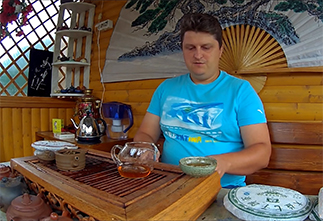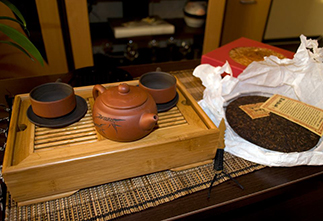Shu Puer 2017 "Spring Dawn" from Chashuwan: Awakening Spring in Every Cup
Shu Puer 2017 "Spring Dawn" (春晓, pinyin chūnxiǎo) from the Chashuwan factory (茶树王, pinyin Cháshù wáng) is an exquisite example of traditional Yunnan puer that will give you an unforgettable experience. Aged for seven years, this tea has acquired a soft, harmonious taste and a rich aroma that awakens and inspires.
History of creation and features
Chashuvan Tea Factory is famous for its high-quality pu-erhs, which are produced using traditional technologies. Shu Pu-erh "Spring Dawn" is the result of many years of experience and skill of tea masters. For its creation, the highest quality raw materials were used, collected in the best tea gardens of Yunnan. Careful fermentation in heaps allowed to obtain tea with a bright, rich taste and multifaceted aroma.
- Manufacturer: Chashuwan is one of the famous puer producers in China.
- Name: "Spring Dawn" - a poetic name that reflects the character of this tea: fresh, bright, with notes of awakening.
- Raw materials: High quality tea leaves with a high content of tea buds, collected in 2017.
- Fermentation: Traditional heap fermentation.
- Pressing: Damn.
Taste and aroma
When dry, the tea has a soft, subtle aroma with a caramel-woody profile.
After the first steeping, pu-erh reveals a bright trail of aromas with a creamy nuance, with notes of wet wood and dried almonds.
The infusion of brewed tea is thick, oily and rich. The taste is clean, balanced, fresh. The taste combines nuts with notes of spring primroses and nutty-creamy echoes. The tea can be brewed up to 5 times, with each new infusion revealing new facets of taste.
The infusion is clean and transparent , of an attractive dark burgundy color.
The aftertaste is long-lasting with notes of dark chocolate, enveloping the entire mouth with its thickness.
Beneficial properties
Like other types of puer, Shu Puer "Spring Dawn" has a number of beneficial properties:
- Improving digestion: Promotes normal digestion and metabolism.
- Toning the body: Increases vitality and vigor.
- Antioxidant properties: Protects the body's cells from the harmful effects of free radicals.
- Beneficial effects on the cardiovascular system: Helps lower cholesterol levels and improve blood circulation.
How to brew
To brew this puer, it is recommended to use a Yixing clay teapot or porcelain gaiwan. The water temperature should be about 95°C. 7-10 grams of dry tea leaves are enough for one brewing.
Why is it worth trying this pu-erh?
- High quality: Produced by one of the famous Chinese tea factories.
- Balanced taste: Combines softness and brightness.
- Beneficial properties: Has a beneficial effect on the body as a whole.
- Versatility: Suitable for daily use.
Shu Puer 2017 "Spring Dawn" from Chashuwan is a true masterpiece of tea art, worthy of the most discerning connoisseurs. Its exquisite taste and subtle aroma will take you to the world of spring gardens of Yunnan.
This pancake is presented by a textured homogeneous raw material with a high content of tea buds. When warmed up with your breath, you can feel a soft, subtle aroma with a caramel-wood profile. After the first pour, pu-erh opens up with a bright trail of aromas with a creamy nuance, with notes of wet wood and dried almonds.
The infusion of brewed tea is thick, oily and rich. The taste is clean, balanced, fresh. The taste combines nuts with notes of spring primroses and nutty-creamy echoes. This tea can be brewed up to 5 times at a ratio of 7 g of tea per 150 ml of Yixing clay teapot or gaiwan.
The infusion is clean and transparent, of an attractive dark burgundy color. The aftertaste is long with notes of bitter chocolate, enveloping the entire oral cavity with its thickness.
Shu Puer 2017 "Spring Dawn" gently tones, sobers and awakens, helps to concentrate and tune in to communication.
Its pure taste and soft tea effect make this puer a tea option for every day, including for tea drinking in the evening.
|
Name in Chinese
|
春晓 |
|
Pinyin
|
chūnxiǎo |
|
Translation
|
Spring Dawn |
|
Country
|
China |
|
Provinces
|
Yunnan (云南) |
|
Manufacturer
|
Чашуван (茶树王) |
|
Year of pressing
|
2017 |
|
Pressing form
|
Bing Cha (Cake Tea) |
|
Declared weight, g
|
357 |
- Комментарии
- Вконтакте
Pu-erh is one of the most unique types of tea, which only gets better with age. Many people, when they first encounter this tea, wondered: why is pu-erh more often found in pressed form (cakes, bricks, tochas), and not in loose form? The reasons for this are related to both history and the practical aspects of storing and fermenting tea. Despite modern technologies that allow the production of loose pu-erh, the shape of pressed cakes remains unchanged. And pu-erh is more often found on sale in pressed form, for example, in the form of cakes or bricks, and loose pu-erh is less common. We will talk about the reasons for pressing pu-erh into cakes in this article.
Puer is a unique Chinese tea that is distinguished by its depth of taste, complexity of aromas and versatility of aftertaste. Its taste characteristics are formed under the influence of many factors, from growing conditions to the brewing method. Let's look at the main ones.
The question often arises: how to brew puerh correctly? Sometimes the phrase "to get high" is added to it. Moreover, everyone has their own understanding of this phrase. Some mean vigor, and some - intoxication. So how to brew puerh tea correctly? Let's consider several options.
Traveling through the tea mountains, we found ourselves in another land of blue roofs - the village of Zhongcai, which is located in the Menghai district of Yunnan province. According to tradition, we were shown another local tea tree, which, according to the Chinese, is at least a million years old :) The village is very authentic, not designed for tourists, there are many wild pu-erhs there and, of course, we were warmly received. They treated us to local cuisine and tea. We also asked the residents about the prices of tea and how they have changed in recent years.
The tea ceremony occupies a special place in the centuries-old Eastern tradition. And although the essence of this phenomenon remains constant, the nature and external manifestations of the tea ceremony in different nations have their own national characteristics. In each Chinese province, the tea ceremony and the tea used in it are varied: for example, residents of the southern provinces prefer green tea, and residents of the northern provinces - red tea, in Fujian province they more often use Oolong tea, and in Yunnan province Puer tea is widely known.


























































































